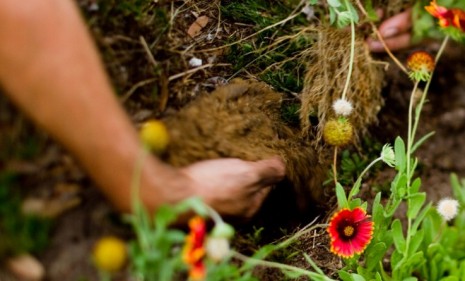Why pregnant women eat dirt
A new book sheds light on "pica" — the overwhelming urge, particularly among pregnant women, to eat nonfood items

Being pregnant does weird things to your appetite. It can make you crave food at all times of day and night, or salivate for odd combinations such as ice cream with pickle juice. Some mothers-to-be, though, crave food that is not food at all — a phenomenon known as "pica." Author Sera Young released a book this month on this seemingly unsavory urge. Here's a quick guide:
What is pica?
"Pica is the scientific term for the craving and subsequent consumption of nonfood items," writes Young. The word comes from the Latin for "magpie." The eating of dirt, clay, or earth is referred to as "geophagy" in modern medical literature.
The Week
Escape your echo chamber. Get the facts behind the news, plus analysis from multiple perspectives.

Sign up for The Week's Free Newsletters
From our morning news briefing to a weekly Good News Newsletter, get the best of The Week delivered directly to your inbox.
From our morning news briefing to a weekly Good News Newsletter, get the best of The Week delivered directly to your inbox.
So... why do pregnant women eat dirt?
Scientists haven't pinned down an exact reason, writes Young, but it's either a response to mineral deficiencies or an instinctual effort to "protect against harm from toxins and pathogens." Clay has a high mineral content, says Marc Lallanilla at ABC News, and is often rich in calcium, iron, copper, and magnesium. "These are essential minerals for the human diet, but even more critical during pregnancy." It may also help with the symptoms of morning sickness.
Is pica just eating dirt?
No. Ice is by far the most common nonfood item enjoyed by pregnant women, reports Mental Floss. It's so common it has its own term — "pagophagy." Certain expectant women also enjoy chowing down on laundry soap, chalk, and talcum powder.
A free daily email with the biggest news stories of the day – and the best features from TheWeek.com
Is pica unique to pregnant women?
No — but it does happen primarily to pregnant women. In some cultures, says Maggie Koerth-Baker at BoingBoing, "eating dirt is the go-to pregnancy 'gotcha' symptom" — the telltale equivalent of morning sickness. Children have also been known to succumb to pica, writes Young, although there are few studies to back that up. A 1990 study found that 1.7 percent of children in upstate New York regularly ate nonfood items.
How common is this?
It's a worldwide phenomenon. Although only 0.01 percent of pregnant women in Denmark admit to eating dirt or clay, as many as 56 percent of pregnant Kenyan women do so, writes Young. It's common enough in the U.S. that a shop in White Plains, Ga., sells "geophagic earth," or kaolin, to those hungering for the taste of clay.
Isn't it bad for you?
No. Clay and dirt are easily digestible, and most people who practice geophagy make sure they're eating clean or fresh earth from the subsurface of the ground. Bacteria, parasites, and other pathogens are normally found higher up, in the topsoil. The only downside of eating clay is that it can give you constipation. Kaolin, or white clay, is the active ingredient in anti-diarrhea medicine Kaopectate.
What does it taste like?
Experts say really good clay can taste "the way that the ground smells when it's real dry and a little sprinkle of rain falls." There's really only one way to find out, though — head out to the garden and try some yourself.
Sources: Craving Earth, BoingBoing, ABC News, Mental Floss
-
 Netflix and Warner Bros: a Hollywood ending for streaming giant?
Netflix and Warner Bros: a Hollywood ending for streaming giant?Talking Point The deal, symptomatic of Silicon Valley’s ‘grasp’ on entertainment, could entirely ‘reshape’ the industry
-
 Did Trump just end the US-Europe alliance?
Did Trump just end the US-Europe alliance?Today's Big Question New US national security policy drops ‘grenade’ on Europe and should serve as ‘the mother of all wake-up calls’
-
 How the War Department became the Department of Defense – and back again
How the War Department became the Department of Defense – and back againIn Depth In 1947 President Harry Truman restructured the US military establishment, breaking with naming tradition